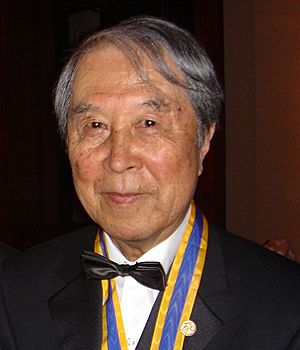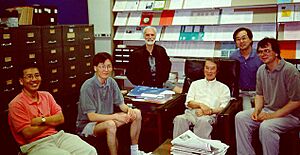Yoichiro Nambu facts for kids
Quick facts for kids
Yoichiro Nambu
南部 陽一郎 |
|
|---|---|

Nambu in 2005
|
|
| Born | 18 January 1921 |
| Died | 5 July 2015 (aged 94) Toyonaka, Osaka, Japan
|
| Citizenship | United States (1970–2015) |
| Alma mater | Tokyo Imperial University |
| Known for | Spontaneous symmetry breaking String theory Nambu–Goto action Nambu-Goldstone boson Nambu mechanics Nambu–Jona-Lasinio model |
| Spouse(s) | Chieko Hida |
| Children | 1 Son (John) |
| Awards | Heineman Prize (1970) J. Robert Oppenheimer Memorial Prize (1976) Order of Culture of Japan (1978) US National Medal of Science (1982) Max Planck Medal (1985) Dirac Medal (1986) J.J. Sakurai Prize (1994) Wolf Prize in Physics (1994/1995) Franklin Medal (2005) Pomeranchuk Prize (2007) Nobel Prize in Physics (2008) |
| Scientific career | |
| Fields | Physics |
| Institutions | University of Tokyo (1942–49) Osaka City University (1949–52) Institute for Advanced Study (1952–54) University of Chicago (1954– 2015) |
Yoichiro Nambu (南部 陽一郎, Nanbu Yōichirō, 18 January 1921 – 5 July 2015) was a Japanese-American physicist. He was a professor at the University of Chicago. He is famous for his important work in theoretical physics.
In 2008, he won half of the Nobel Prize in Physics. He received it for his discovery in 1960 of something called "spontaneous broken symmetry." This idea helps us understand how tiny subatomic particles behave. It was first linked to the strong interaction (one of the basic forces of nature). Later, it helped explain the electroweak interaction and the Higgs mechanism. The other half of the Nobel Prize went to Makoto Kobayashi and Toshihide Maskawa. They discovered why this symmetry breaks, which showed that there are at least three types of quarks.
Contents
Early Life and Education
Yoichiro Nambu was born in Tokyo, Japan, in 1921. After finishing high school in Fukui City, he went to the Imperial University of Tokyo. There, he studied physics.
He earned his first degree in 1942. Later, he received his doctorate (a higher degree) in 1952. In 1949, he became an associate professor at Osaka City University. The very next year, at just 29 years old, he became a full professor.
In 1952, Nambu was invited to study in the United States. He went to the Institute for Advanced Study in Princeton, New Jersey. He then moved to the University of Chicago in 1954. By 1958, he was a full professor there. From 1974 to 1977, he was also in charge of the Physics Department. He became a citizen of the United States in 1970.
Discoveries in Physics
Nambu made many important discoveries in physics. He suggested the idea of "color charge" in quantum chromodynamics. This is a property that tiny particles called quarks have, similar to how particles can have an electric charge.
He also did early work on spontaneous symmetry breaking in particle physics. This idea helps explain why some fundamental rules of nature seem to be broken, even though they are not. This breaking of symmetry is very important for understanding how the universe works at a tiny level.
Nambu also found that a model called the "dual resonance model" could be explained as a quantum theory of strings. This was a big step towards developing string theory. Because of this, he is known as one of the people who helped start string theory. String theory suggests that the smallest parts of the universe are not tiny points, but tiny vibrating strings.
After working for over fifty years as a professor, he became a retired distinguished professor at the University of Chicago. He worked in the Department of Physics and the Enrico Fermi Institute.
Two important concepts in physics are named after him. The Nambu-Goto action in string theory is named after Nambu and Tetsuo Goto. Also, tiny particles called bosons that appear when spontaneous symmetry breaking happens are sometimes called Nambu–Goldstone bosons.
Later Life and Passing
Yoichiro Nambu passed away on July 5, 2015, in Osaka, Japan. He was 94 years old. He died from a heart attack. His funeral and memorial services were private, held only with close family.
Awards and Recognition
Nambu received many awards and honors for his work. Some of these include:
- The Dannie Heineman Prize (1970)
- The J. Robert Oppenheimer Memorial Prize (1977)
- Japan's Order of Culture (1978)
- The U.S.'s National Medal of Science (1982)
- The Max Planck Medal (1985)
- The Dirac Prize (1986)
- The Sakurai Prize (1994)
- The Wolf Prize in Physics (1994/1995)
- The Franklin Institute's Benjamin Franklin Medal (2005)
As mentioned, he was awarded one-half of the 2008 Nobel Prize in Physics. This was for his discovery of how "spontaneous broken symmetry" works in the world of subatomic particles.
See also
- List of Japanese Nobel laureates
- List of Nobel laureates affiliated with the University of Tokyo
- In Spanish: Yoichiro Nambu para niños


